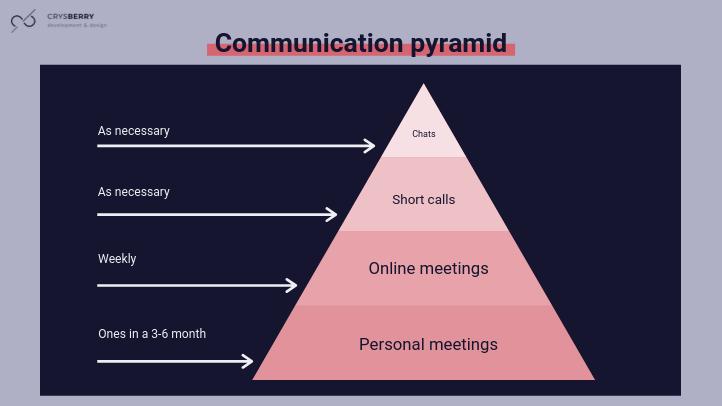Software development team organization: mistakes and solutions
Crysberry, Management
16 September 2019The process of software development team organization can be tricky and not that easy. You must understand that this might be the most important step defining the success of your project.
Thinking about different risks in advance will help to avoid common mistakes in the software development process.

So let’s take a look at this topic in more detail.
Step One: Creating a software development team
Follow these tips to avoid the most common mistakes while creating a team for a software development process.
Your needs must be determined.
Know the purpose of setting up a team. Don’t forget to plan the number of employees and all the resources needed (hardware, software, etc.). This will help you to stay focused and estimate all the spends. Additionally, you can better attract individuals to join your team when you ensure that everything is fully equipped.
Do not settle for second best.
To set up a development team start-up companies can practice hiring a lower rate developer. Usually, limited funds make companies do this. However, don’t forget that the quality of your team level determines the success of a team and an overall project. Picking the right hires is the most important step of your project. So, think twice to avoid cases when an attempt to save money leads to even higher spends. For example, when the qualification of a lower rate person is not enough to fulfill all the requirements. So you might need an employee to spend more time to re-work the task or even find someone else to complete the work.
Search for team players.
A person can have a great level of professional skills, but if he is not able to deal with the team it can lead to overall fail. So, while looking for candidates to join your team, don’t forget to determine:
- Whether a particular person is a good team member or not.
- Whether his skills and personal qualities are appropriate enough for productive work.
To make the right choice, ask yourself “I would not go in exploration with him”. In other words, could you trust him with a task which you are responsible for?
Use IT outsource software development.
Outsourcing can save your money and provide you with a wide choice of a highly qualified specialist. For more details, feel free to check our dedicated article: IT outsourcing situation: sunset or rise?
Step Two: Working on a project
There can be lots of things that cause project failure. Some of them can be controlled or mitigated. Let us show you what risks you can try to prevent.
Overthinking technology, forgetting business.
Start with questions about your business before going on with the technology. Business goals must define your project, not the choice of technologies for it.
Underestimating UX/UI.
Users must drive IT evolution, not vice versa. The most innovative software solution will fail if no one uses it. By spending efforts on UX/UI research and design, you can avoid an overall project failure. We have covered this topic in detail in Development and design interaction overview article.
No fragmentation for large projects.
Divide the project into milestones and limit the scope for success. This helps to concentrate on exact tasks before taking others into work. Otherwise, working on all sides of a large project at once will definitely end with failure.
Temporary solutions.
You can come across difficulties when a developer can’t meet the deadline to complete the required scope or to make the work simple. So temporary solutions might seem a good way out to finish tasks in time for different reasons: less time required, simpler code, simplified design and so on. But the decision that is being realized here and now can exist for years without changes and intertwine with other parts of the application so closely that it will be extremely difficult to replace it.
No testing.
Create prototypes and test them before the final development stages. If you don’t think that this step is essential, ask yourself if you would ever buy a car without a test-drive road.
Failing communication.
Structured & ritualized conversations are key. Communication involves people. Productive conversations can help all parties work effectively together. You must build the mechanism of communication in advance and make all the involved parties follow it. Especially, if we are talking about outsourcing parties.
Underestimating project leader role.
A project manager as a great communicator is of utmost importance. The business plan, accounts, and contracts should already be in place. Each member of the team needs to be sure of what their roles are and what is expected of them. Keeping these requirements is monitored by the project leader. Team conflict management and motivations are also handled by this person.
Communication is the key to a successful development process
According to Grant Thornton’s International Business Report, communication is the key to outsourcing success with 98% of UK respondents saying so. This is applicable not only to outsourcing but to dealing with any kind of team.
Here are some suggestions on building effective communication:
- Build a communication mechanism with a development team. You can use a set of them combined into a so-called communication pyramid. Here’s an example:

- Make all the requirements clear from the very beginning.
- Continue collaborating with your team and take an interest in what is going on.
- Discuss the importance of documentation and create a system that will be easy to follow and track.
- Find a good project manager to control the communication on all levels.
Conclusion
Software development team organization and management is not that easy. You need to evaluate the main risks in advance and do your best to mitigate them. Remember to build communication in the most effective way to be on the same side with all the stakeholders and the development team.
l.sidorenko